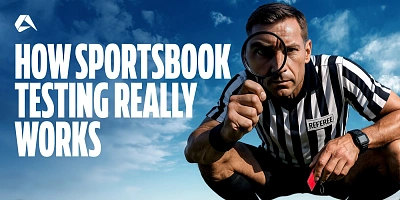Overview Metrics That Matter in 2024 - Key KPIs for Boosting Sports Betting Revenue
The article, "Metrics That Matter in 2024 - Key KPIs for Boosting Sports Betting Revenue," highlights the critical role of Key Performance Indicators (KPIs) for sports betting operators. These metrics offer a clear assessment of business health, operational effectiveness, and strategic impact, helping identify areas for improvement, maintain competitiveness, and drive revenue.
The piece categorises essential KPIs into three groups. Financial KPIs, including Gross Gaming Revenue (GGR), Net Gaming Revenue (NGR), and Average Revenue Per User (ARPU), are fundamental for understanding profitability and economic health, optimising revenue streams, and identifying cost inefficiencies. GGR shows total revenue before deductions, NGR reveals actual profit after bonuses and taxes, and ARPU offers insights into user spending habits.
Customer Acquisition and Retention KPIs – Cost Per Acquisition (CPA), Customer Lifetime Value (CLV), and Churn Rate – are vital for assessing marketing efficiency and player loyalty. CPA measures new customer acquisition costs, CLV indicates a customer's total revenue contribution over time, and Churn Rate tracks customer attrition, aiding retention strategies.
Lastly, Engagement and Activity KPIs like Handle (total money wagered), Hold Percentage (revenue retained from wagers), and In-play Betting Percentage (popularity of live betting) reveal user interaction and betting patterns.
The article also delves into advanced metrics and tools such as AI, machine learning, and comprehensive dashboards, which enhance KPI tracking, provide predictive analytics, and enable data-driven decisions. Future trends like blockchain and IoT are set to further revolutionise data collection and personalisation. Ultimately, leveraging these KPIs is crucial for boosting satisfaction and maximising revenue in a competitive market.
For sports betting operators, key performance indicators (KPIs) matter. They provide a clear assessment of how the business is doing and the overall effectiveness of operations and strategies over time. When used and interpreted correctly, KPIs identify areas for improvement and the steps that must be taken to maintain competitiveness, drive revenue and reach business goals and objectives.
With this in mind, leading sportsbook software provider Altenar has put together a list of the most important KPIs to consider, along with the critical insights they provide for betting operators in 2024.
| KPI Group | Key Indicators | Measurement of | Insights Provided |
|---|---|---|---|
| Financial | GGR NGR ARPU | The economic health and profitability of a business | Revenue generation trends. Profitability analysis. Cost management efficiencies. |
| Customer | CPA CLV Churn | The effectiveness at attracting and maintaining a customer base | Efficiency of marketing strategies. Long-term value of customers. Customer retention effectiveness. |
| Engagement | Handle. Hold % In-play Bet % | The level of user interaction and activity | Profitability of odds setting. Efficiency of promotional offers. Identification of betting patterns and popular events. |
Financial KPIs
Financial KPIs, such as Gross Gaming Revenue (GGR), Net Gaming Revenue (NGR), and Average Revenue Per User (ARPU), are primary metrics that measure the financial performance of a sports betting operation. These KPIs are fundamental because they provide a clear picture of the economic health and profitability of a betting business. Understanding and evaluating these KPIs enhances strategic decision-making, optimises revenue streams, and ensures sustainable growth.
Accurate financial KPIs help to identify revenue drivers, cost inefficiencies and revenue trends to boost overall profitability.
Gross Gaming Revenue (GGR)
Gross Gaming Revenue (GGR) is a standard measure of a sportsbook's economic value, representing the total amount wagered by players minus the winnings paid out. It provides a clear picture of the revenue generated from betting activities before operating expenses, taxes, and other costs are deducted.
For online betting operators in 2024, tracking GGR helps assess overall performance, optimise game offerings, and manage marketing strategies. By analysing GGR trends, operators can identify profitable segments, adjust pricing strategies, and enhance revenue generation efforts, ensuring sustainable business growth.
Furthermore, by tracking GGR, operators can gauge the success of their promotional strategies, gain a better understanding of player behaviour, and identify trends in betting activity. For example, GGR analysis can be used to pinpoint which sports and events are most popular among bettors so that operators can tailor their offerings and marketing efforts more efficiently. Moreover, GGR is an indispensable metric for financial forecasting and planning. It shows projected future revenue streams and helps operators make informed decisions about resource allocation, investment in new technologies, expansion into new markets, etc.
Net Gaming Revenue (NGR)
Net Gaming Revenue (NGR) represents the actual profit from gaming activities after deducting bonuses, promotional costs, and taxes from Gross Gaming Revenue (GGR), calculated as GGR minus these expenses. In short, it provides a clearer picture of an online sportsbook's profitability and financial health and is, therefore, an essential indicator for the development of financial strategies.
This metric helps operators understand the profitability of a platform's promotions and marketing efforts. By evaluating NGR, operators can subsequently refine financial strategies, optimise resource allocation, and enhance overall operational efficiency.
Average Revenue Per User (ARPU)
Average Revenue Per User (ARPU) measures the average revenue generated by each user over a specified period. It is calculated by dividing total revenue by the number of active users. ARPU provides valuable insights into user spending habits and overall profitability. An understanding of ARPU helps sports betting operators identify high-value customers, optimise engagement initiatives and tailor marketing strategies.
Furthermore, knowledge of ARPU trends provides the information needed to optimise pricing, enhance user engagement, and boost customer retention efforts.
Customer Acquisition and Retention KPIs
Customer acquisition and retention KPIs provide invaluable insights into how effective an operation is at attracting and maintaining its player base. Key metrics include Cost Per Acquisition (CPA), Customer Lifetime Value (CLV), and Churn Rate. At their core, customer-related KPIs highlight the efficiency of ongoing marketing strategies, the long-term value generated by players, and the effectiveness of player retention efforts.
Understanding and tracking key betting business KPIs like this enable operators to optimise marketing spend, enhance player loyalty, and ultimately boost revenue.
Cost Per Acquisition (CPA)
The cost per acquisition KPI measures the cost of acquiring a new customer. It is calculated by dividing total marketing expenses by the number of new customers acquired. CPA provides an overview of the efficiency of marketing strategies in line with budget allocation. An understanding of CPA ultimately helps in evaluating the effectiveness of various campaigns and optimising marketing spend. Moreover, by assessing CPA alongside retention metrics like Customer Lifetime Value (CLV), operators can fine-tune sustainable growth and maximise return on investment.
Customer Lifetime Value (CLV)
Customer Lifetime Value (CLV) measures the total revenue a customer generates throughout their relationship with a business. It is calculated by multiplying the average purchase value, purchase frequency, and the lifespan of customer engagement with a platform. CLV offers a deeper understanding of average customer profitability and helps operators assess the long-term value of their acquisition strategies. With this information, operators can identify high-value customers, tailor retention strategies, and optimise marketing expenditure to enhance customer loyalty and profitability.
Churn Rate
Churn rate measures the percentage of customers who stop using a service over a specified period. It is calculated by dividing the number of customers lost during a period by the total number at the start, then multiplying by 100. Churn rate provides operators with essential observations into overall customer satisfaction and retention effectiveness. Analysing churn rates helps to identify factors driving customer attrition, enabling them to develop targeted retention strategies and improve user experience.
Engagement and Activity KPIs
Engagement and activity KPIs measure the level of user interaction and activity within a sports betting platform. These KPIs provide invaluable insights into player behaviour, betting patterns, and platform engagement. For iGaming operators, understanding and tracking these KPIs helps in enhancing user experience, optimising product offerings, and increasing betting activity.
Effective management of engagement KPIs leads to higher player satisfaction, retention, and subsequently, increased revenue.
Handle
The Handle KPI measures the total amount of money wagered by players on a sports betting platform. This metric offers insights into the level of user engagement and betting activity on a platform. High handle figures indicate sturdy player participation and effective marketing strategies. By analysing handle trends, sports betting operators can identify popular events, optimise promotional efforts, and enhance user engagement. Armed with this knowledge, businesses are better placed to allocate resources efficiently and tailor offerings to player preferences.
Hold Percentage
The Hold Percentage KPI measures the percentage of total wagers that a sports betting platform retains as revenue. This metric provides awareness of the profitability and effectiveness of odds setting. High hold percentages indicate efficient revenue generation. By analysing hold percentage trends, operators can optimise their odds, manage risk, and ensure a balance between attractive payouts and profitability. Betting operators can use this KPI to fine-tune betting strategies.
In-Play Betting Percentage
The In-play Betting Percentage KPI measures the proportion of bets placed on live events compared to total bets. Ultimately, it offers insights into the popularity of live betting features and player engagement with this form of betting. For example, a high percentage indicates a strong interest in live betting, guiding operators to enhance real-time data and betting options. By scrutinising this KPI, operators can make improvements to user experience and boost engagement through targeted promotions and optimised live betting features.
Advanced Metrics and Tools
Advanced metrics and tools offer sports betting operators, and online casino operations, for that matter, enhanced tracking and deeper insights into KPIs. By using real-time analytics platforms, operators are provided the ability to monitor user behaviour, betting patterns, and financial performance with precision. Moreover, modern tools such as machine learning algorithms and predictive analytics greatly enhance trend forecasting to optimise marketing strategies and platform offerings.
In addition, advanced dashboards can aggregate data from multiple sources nowadays, providing operators with a holistic view of operations. These advanced tools help iGaming professionals make accurate data-driven decisions, improve user engagement, and maximise revenue, ensuring a competitive edge in the online betting marketplace.
AI and Machine Learning
The use of AI and machine learning significantly enhances the ability of sports betting operators to track and optimise KPIs. These technologies enable advanced player segmentation by analysing vast amounts of data to identify patterns and preferences, thus allowing for highly targeted marketing efforts. Personalisation is improved as AI-driven systems can tailor offers and experiences to individual users, increasing engagement and player retention.
Predictive analytics powered by machine learning can forecast user behaviour and betting trends, facilitating proactive adjustments to strategy. Altogether, such efficiencies lead to better resource allocation, improved user satisfaction, and maximised revenue, providing operators with a greater competitive advantage.
Dashboard and Analytics Tools
Dashboard and analytics tools are indispensable for sports betting operators aiming to boost revenue. These integrated platforms allow for real-time monitoring of multiple KPIs such as Gross Gaming Revenue (GGR), Net Gaming Revenue (NGR), and Average Revenue Per User (ARPU). They work by aggregating data from various sources into one unified interface, providing a comprehensive overview to aid timely decision-making.
With the ability to visualise trends and inconsistencies instantly, operators can swiftly adjust strategies, optimise marketing efforts, and enhance user engagement. Moreover, users are typically provided with the flexibility to drill down into specific metrics to enhance decision-making processes, leading to improved operational efficiency and profitability.
Future Trends
Further to the advanced technology currently in use, the future of KPI tracking and analysis in the iGaming industry is poised to be shaped by a number of key technological advancements and trends. Personalisation, for instance, will undoubtedly become even more sophisticated, offering tailored content and betting options based on individual user profiles. Data visualisation tools and dashboards will also continue to become standard, allowing users to easily interpret complex data sets and trends.
Blockchain technology is also positioned to have a greater influence on KPIs, providing transparent, tamper-proof data tracking. This technology also offers more secure and reliable monitoring of financial transactions, enhancing trust among stakeholders. Further to this, the use of IoT devices (Internet of Things) will give iGaming operators the ability to gather more granular data, since smart devices and sensors can provide detailed observations of user interactions and preferences. Technologies such as these collectively lead to more targeted and effective marketing campaigns, driving revenue growth and operational efficiency.
Advanced Insights for Operators in 2024
Altenar’s turnkey sportsbook solution provides scalable and flexible technology with customisable software and tools designed to help operators stand out from the crowd and get ahead.
Drive customer satisfaction to boost revenue with Altenar’s advanced reporting and marketing tools and gain deeper insights into player behaviour with our fully integrated PAM system.
Experience the difference for yourself. Book a demo today and give your platform the competitive edge it needs to thrive.













